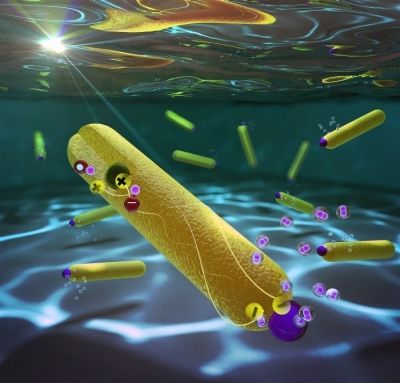Page 8847
Feb 22, 2016
Etch transfer into silicon of patterns with a half-pitch of under 20nm
Posted by Karen Hurst in category: futurism
An etching process based on a three-layer stack achieves transfer into silicon of patterns with a depth of less than 5nm and a half-pitch of less than 20nm written by thermal scanning probe lithography.
Feb 22, 2016
Nanoscale system reaches perfect efficiency for solar fuel production step
Posted by Karen Hurst in categories: energy, materials, nanotechnology, sustainability
A major goal in renewable energy research is to harvest the energy of the sun to convert water into hydrogen gas, a storable fuel. Now, with a nanoparticle-based system, researchers have set a record for one of the half-reactions in this process, reporting 100% efficiency for the reduction of water to hydrogen (Nano Lett. 2016, DOI: 10.1021/acs.nanolett.5b04813).
To make such water-splitting systems, researchers must find the right materials to absorb light and catalyze the splitting of water into hydrogen and oxygen. The two half-reactions in this process—the reduction of water to hydrogen gas, and the oxidation of water to oxygen gas—must be isolated from each other so their products don’t react and explode. “Completing the cycle in an efficient, stable, safe fashion with earth-abundant elements is an ongoing challenge,” says chemist Nathan S. Lewis of Caltech, who was not involved in this study.
Until recently, the efficiency of the reduction step had maxed out at 60%. One challenge is that electrons and positive charges formed in the light absorption process can rapidly recombine, preventing the electrons from reducing water molecules to form hydrogen. To overcome this problem, several years ago, Lilac Amirav of Technion–Israel Institute of Technology and her colleagues designed a nanoparticle-based system (J. Phys. Chem. Lett. 2010, DOI: 10.1021/jz100075c) that would physically separate the charges formed during photocatalysis.
Continue reading “Nanoscale system reaches perfect efficiency for solar fuel production step” »
Feb 22, 2016
Target Practice in Russia Means Blowing Up Asteroids With Ballistic Missiles
Posted by Karen Hurst in categories: military, space
Russia isn’t messing around.
It’s for a good cause — but you have good reason to be scared.
Feb 22, 2016
Vibrating Bat Wings Inspire Efficient Sea-Skimming Drones
Posted by Karen Hurst in categories: drones, transportation
Feb 22, 2016
Astronomers discover 300,000-light-year-long gas tail stretching from galaxy
Posted by Karen Hurst in categories: materials, physics, space
Astronomers have found an extraordinary trail of gas greater than 300,000 light years across originating from a nearby galaxy called NGC 4569, according to a report in Astronomy & Astrophysics.
The tail is comprised of hydrogen gas, the material new stars are born from, and is five times longer than the galaxy itself.
Feb 22, 2016
Paper demonstrates autonomous underwater vehicles can be pre-programmed to make independent decisions
Posted by Karen Hurst in categories: robotics/AI, transportation
Brings a lot of possibilities.
Robotic reasoning.
Paper demonstrates autonomous underwater vehicles can be pre-programmed to make independent decisions.
Feb 22, 2016
Quantum Phase Transition Underpins Superconductivity in Copper Oxides
Posted by Karen Hurst in categories: materials, quantum physics
Physicists have zoomed in on the transition that could explain why copper-oxides have such impressive superconducting powers.
Settling a 20-year debate in the field, they found that a mysterious quantum phase transition associated with the termination of a regime called the “pseudogap” causes a sharp drop in the number of conducting electrons available to pair up for superconductivity. The team hypothesizes that whatever is happening at this point is probably the reason that cuprates support superconductivity at much higher temperatures than other materials—about half way to room temperature.
“It’s very likely that the reason superconductivity grows in the first place, and the reason it grows so strongly, is because of that critical point,” CIFAR Senior Fellow Louis Taillefer (Université de Sherbrooke) says. The new findings are published in Nature.
Feb 22, 2016
RMIT Researchers Examine Environmental and Health Risks Posed by 3D Printing
Posted by Karen Hurst in categories: 3D printing, computing, health, materials
3D Printing hazardous to the environment due to toxins.
Three-dimensional (3D) printing, also known as additive manufacturing, refers to those technologies capable of developing 3D objects from raw materials, like metals and polymers based on computerized 3D parametric models.
Feb 22, 2016
Breaking Through the Bacteria Barrier
Posted by Karen Hurst in categories: bioengineering, biotech/medical, genetics
Breaking the bacteria barriers.
If that field is at just the right magnitude, it will open up pores within the cell membrane, through which DNA can flow. But it can take scientists months or even years to figure out the exact electric field conditions to reversibly unlock a membrane’s pores.
A new microfluidic device developed by MIT engineers may help scientists quickly home in on the electric field “sweet spot” — the range of electric potentials that will harmlessly and temporarily open up membrane pores to let DNA in. In principle, the simple device could be used on any microorganism or cell, significantly speeding up the first step in genetic engineering.















